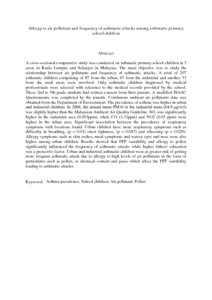Citation
Zakaria, Junaidah and Lye, Munn Sann and Hashim, Jamal Hisham and Hashim, Zailina
(2010)
Allergy to air pollution and frequency of asthmatic attacks among asthmatic primary school children.
American-Eurasian Journal of Toxicological Sciences, 2 (2).
pp. 83-92.
ISSN 2079-2050; ESSN: 2079-2069
Abstract
A cross-sectional comparative study was conducted on asthmatic primary school children in 3 areas in Kuala Lumpur and Selangor in Malaysia. The main objective was to study the relationship between air pollutants and frequency of asthmatic attacks. A total of 207 asthmatic children comprising of 87 from the urban, 67 from the industrial and another 53 from the rural areas were involved. Only asthmatic children diagnosed by medical professionals were selected with reference to the medical records provided by the school. These 2nd to 5th grade students had written consent from their parents. A modified ISAAC Questionnaire was completed by the parents. Continuous ambient air pollutants data was obtained from the Department of Environment. The prevalence of asthma was higher in urban and industrial children. In 2008, the annual mean PM10 in the industrial areas (64.9 μg/m3) was slightly higher than the Malaysian Ambient Air Quality Guideline. SO, was significantly higher in the industrial area (0.003ppm), while CO (1.31ppm) and NO2 (0.03 ppm) were higher in the urban area. Significant association between the prevalence of respiratory symptoms with locations found. Urban children have more respiratory symptoms such as difficulty in breathing, (p = 0.01) chest tightness, (p = 0.047) and wheezing (p = 0.029). Allergy symptoms such as skin rashes, nasal symptoms and watery eyes and nose were also higher among urban children. Results showed that PEF variability and allergy to pollen significantly influenced the frequency of asthmatic attacks while higher fathers' education was a protective factor. Urban and industrial asthmatic children were at greater risk of getting more frequent asthmatic attack due to allergy to high levels of air pollutants in the form of particulates such as pollen, or chemical content and gases which affect the PEF variability leading to asthmatic attacks.
Download File
![[img]](http://psasir.upm.edu.my/12989/1.hassmallThumbnailVersion/Allergy%20to%20air%20pollution%20and%20frequency%20of%20asthmatic%20attacks%20among%20asthmatic%20primary%20school%20children.pdf)  Preview |
|
PDF (Abstract)
Allergy to air pollution and frequency of asthmatic attacks among asthmatic primary school children.pdf
Download (152kB)
| Preview
|
|
Additional Metadata
Actions (login required)
 |
View Item |

